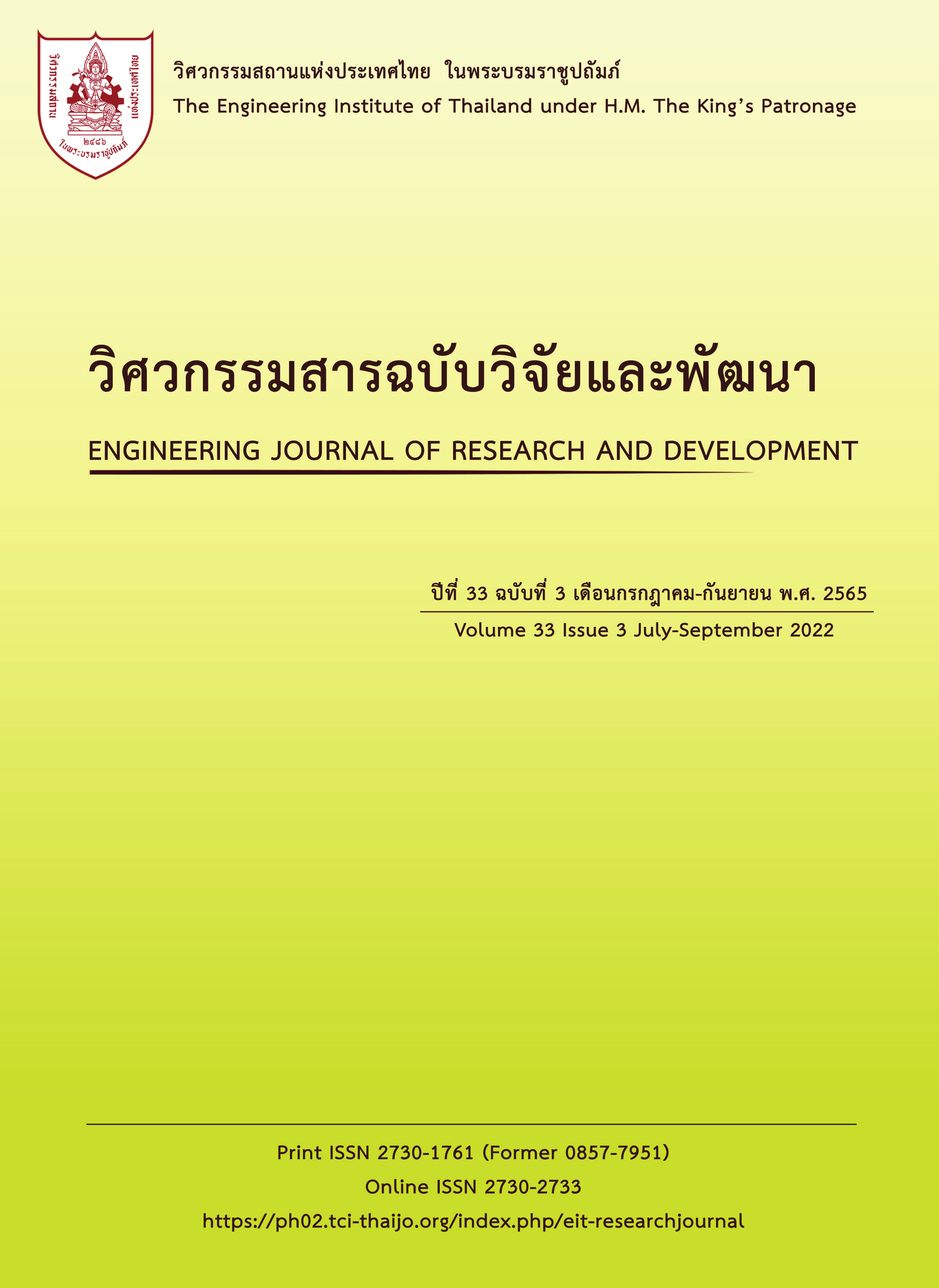USE OF CAR BROKEN GLASS AS FINE AGGREGATE IN MORTAR
Main Article Content
Abstract
This research aims to study the properties of mortars containing car broken glass at 0, 10, 20, 30, 40, 50, 60, 80, and 100% by volume. The physical, mechanical, and thermal properties of mortars were studied. The test results showed that the use of car broken glass to replace natural sand had no effect on the workability, compressive strength, porosity, water absorption, density, and ultrasonic pulse velocity of mortars. This was due to the similar size distribution of car broken glass and natural sand. The thermal conductivity coefficient significantly decreased with the increasing of car broken glass contents. This result pointed out that the car broken glass exhibited thermal insulating property. The developed mortars containing car broken glass in this study were appropriate for use as thermal insulating composites in construction and building materials.
Article Details

This work is licensed under a Creative Commons Attribution-NonCommercial-NoDerivatives 4.0 International License.
The published articles are copyright of the Engineering Journal of Research and Development, The Engineering Institute of Thailand Under H.M. The King's Patronage (EIT).
References
กานต์ธิปก ฮามคำไพ, ภีม เหนือคลอ, พิชชา จองวิวัฒสกุ และ เสวกชัย ตั้งอร่ามวงศ์. สมบัติทางกลของจีโอพอลิเมอร์คอนกรีตที่ใช้มวลรวมละเอียดรีไซเคิลจากเศษหินแกรนิต. การประชุมวิชาการวิศวกรรมโยธาแห่งชาติ ครั้งที่ 25, ชลบุรี, 15-17 กรกฎาคม 2563, หน้า. 1-6.
Tamanna, N., Tuladhar, R., and Sivakugan, N. Performance of recycled waste glass sand as partial replacement of sand in concrete. Construction and Building Materialsr, 2020, 239, pp. 117804.
ไทยรัฐออนไลน์. วิกฤติทรายขาดแคลนทั่วโลก กระทบการผลิต(ขวด)วัคซีนโควิด-19. วิกฤติทรายขาดแคลนทั่วโลก กระทบการผลิต(ขวด) วัคซีนโควิด-19, 2564 (thairath.co.th).[15 พ.ย. 2564]
Adesina, A., and Das, S. Mechanical performance of engineered cementitious composite incorporating glass as aggregates. Journal of Cleaner Production, 2020, 260, pp. 121113.
Sikora, P. et al. Thermal Properties of Cement Mortars Containing Waste Glass Aggregate and Nanosilica. Procedia Engineering, 2017, 196, pp. 159–166.
อภินันท์ ศิริวัฒนกาญจน์. จีโอโพลิเมอร์คอนกรีตผสมมวลรวมจากเศษวัสดุระบบอัด. วิทยานิพนธ์ปริญญาวิศวกรรมศาสตร มหาบัณฑิต สาขาวิชาวิศวกรรมโยธา บัณฑิตวิทยาลัย มหาวิทยาลัยขอนแก่น, 2562.
American Society for Testing and Materials. ASTM C33/C33M-13. Standard Specification for Concrete Aggregates. USA: ASTM, 2016.
American Society for Testing and Materials. ASTM C128. Standard Test Method for Relative Density (Specific Gravity) and Absorption of Fine Aggregate. USA: ASTM, 2015.
American Society for Testing and Materials. ASTM C29. Standard Test Method for Bulk Density (‘Unit Weight’) and Voids in Aggregate. USA: ASTM, 2009.
American Society for Testing and Materials. ASTM C136/C136M: 2014. Standard Test Method for Sieve Analysis of Fine and Coarse Aggregates. USA: ASTM, 2014.
American Society for Testing and Materials. ASTM C109/C109M:2013. Standard Test Method for Compressive Strength of Hydraulic Cement Mortars (Using 2-in. or [50-mm] Cube Specimens). USA:ASTM, 2013.
American Society for Testing and Materials. ASTM C 305. Standard Practice for Mechanical Mixing of Hydraulic Cement Pastes and Mortars. USA: ASTM, 2015.
American Society for Testing and Materials. ASTM C1437. Standard Test Method for Flow of Hydraulic Cement Mortar. USA: ASTM, 2013.
American Society for Testing and Materials. ASTM C642. Standard Test Method for Density, Absorption, and Voids in Hardened Concrete. USA: ASTM, 2013.
American Society for Testing and Materials. ASTM C1754/C1754M-12: 2021. Standard Test Method for Density and Void Content of Hardened Pervious Concrete. USA: ASTM, 2021.
American Society for Testing and Materials. ASTM C597. Standard Specification for Pulse Velocity Through Concrete. USA: ASTM, 2009.
Wang, S., Peng, X., Tang, L., Cao, C. and Zeng, L. Contact-hardening behavior of calcium silicate hydrate powders. Materials, 2018, 11, PP. 1–17.
Estévez, E., Martín, D. A., Argiz, C., and Sanjuán, M. Á. Ultrasonic pulse velocity compressive strength relationship for portland cement mortars cured at different conditions. Crystals, 2020,10, pp. 133.
Hong, G., Oh, S., Choi, S., Chin, W. J., Kim, Y. J., and Song, C. Correlation between the compressive strength and ultrasonic pulse velocity of cement mortars blended with silica fume: An analysis of microstructure and hydration kinetics. Materials (Basel), 2021,14, pp. 0–14.


